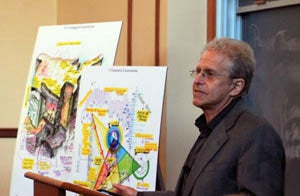Harvard Law School Professor Laurence Tribe’s ’66 new book, “The Invisible Constitution” (Oxford University Press, 2008), was the subject of a star-studded panel discussion sponsored by the Harvard Law Review on April 15 at HLS. In addition to Tribe, Stanford Law School Professor Kathleen Sullivan ’81 and Yale Law School Professor Akhil Amar spoke, with HLS Professor Martha Minow moderating the discussion.
In introducing Tribe, Minow hailed him as “the most distinguished constitutional law scholar of his generation and of our time.” She continued by explaining why Tribe’s book should be read by everyone interested in American constitutional law: “[The book] comes at a time…that the country stands at a crossroads about how to interpret its most basic commitments and aspirations.”
Tribe, who was flanked by numerous large, brightly colored charts he drew to illustrate some of the key ideas in the book, began by explaining the book as a “synthesis” of the ways in which he has always thought about the Constitution. Parts of the Constitution are invisible, he explained, because many of the bedrock principles Americans consider constitutionally ordained are actually not enumerated in the document’s text.
In many ways, the book is a “sketch of work to come,” Tribe said, “as I try to elaborate and still fill in the vast empty spaces of the picture that this book presents of a constitution only partly seen. But I do want to stress that it’s never been my ambition to fill in those spaces altogether. The whole point, in many ways, is that the negative space is an integral part of the picture.”
In his remarks, Amar focused on identifying in what ways portions of the Constitution are invisible. “The text doesn’t contain a set of instructions explaining how to interpret it. In order to understand the text, we have to bring to it some background ideas, principles from the outside,” he said.
Amar went on to identify numerous complicated matters that become clear when interpreting the Constitution. For example, even if one chooses to follow the ‘original intent’ of the authors of the Constitution, that decision leads to several other questions about the authors and even to what extent the original text ought to be weighed against more recent laws that might be in tension with the Constitution. The answers to all such questions are completely invisible, Amar said.
Sullivan began by comparing the book to other well-known constitutional law works, concluding that this book is completely “distinct” and unique for “its insistence on being intra-constitutional.” Unlike most other books about constitutional law, Tribe’s book is not concerned with describing how the Constitution serves a larger goal, such as supporting democracy. Succinctly put, it’s a book that “goes inside the Constitution and sees it from the inside-out,” she said.
Sullivan described the way Tribe thought about the Constitution as geometric in nature, and said that approach has been present in his previous work.
“Larry always insisted in his work on…the three-dimensionality of Constitutional problems,” Sullivan said. For example, the right to die is not just about the right to remove medical instruments from the body; instead, it’s about the right to control the time and circumstances of one’s death.
Moreover, Tribe has consistently developed the idea of “tacit structural postulates in the law”—in other words, there are certain rights that are not specifically enumerated in the Constitution, but that the Constitution no doubt upholds. The right to privacy, or the notion of federalism, are two examples of ideals that the Constitution tacitly upholds, Sullivan said.
Sullivan identified a third and final geometric theme in Tribe’s work, which she identified as “Mobius strips.”
“To see a right in its proper form is not to decide whether it involves liberty or equality, but to see if it can simultaneously involve both, like the continuous feature of a Mobius strip, which has two sides, but one continuous plane,” Sullivan explained.
As an example, Sullivan discussed Tribe’s involvement in Lawrence v. Texas, the well-known 2003 Supreme Court case upholding a Constitutional right to sexual privacy for same-sex couples. Tribe’s argument in the case was not only about the right to privacy for same-sex couples, she said. His argument—and the Court’s decision—was also about granting equality to same-sex citizens. In other words, Tribe’s argument was “that liberty and equality are in service to each other,” Sullivan concluded.
